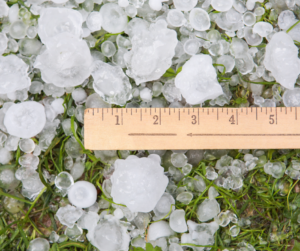Picture a typical Queensland summer day. It starts off with the kind of sunshine that makes you want to drop everything and head to the beach. The sky a brilliant blue, and the warmth of the sun a gentle hug. But as the day wears on, the horizon darkens with ominous black clouds. The air becomes thick and heavy, and the first distant rumbles of thunder signal the arrival of a storm, fat with hail.
Australia is renowned for its excellent weather. And with so much sun here in the north, it is no wonder that so many Australians choose to invest in solar energy and enjoy its benefits. However, Summertime is also known as the wet season, and with it come the occasional severe storm and hail, ready to smash your solar panels to smithereens. Or is it?
How Much Hail Can Solar Panels take?
Solar Panels are pretty tough, made from tempered glass and aluminium. The Australian standards mandate that for a solar panel to be installed here, it needs to pass hail testing.
To pass the Moderate Hail Test, solar panels must be able to survive 25mm diameter ice balls fired at 23m/s on 11 points across the module. A 25mm hailstone is considered to be pretty large, and even in Queensland we don’t experience storms of that magnitude very often. That’s not to say it doesn’t happen, as those in Forestdale, in SEQ experienced hail up to 14 centimetres back in 2020. Because of this, it is a good idea to let your home and contents insurance provider know about your solar installation and confirm that hail damage is covered under your policy.
What to Do After a Hailstorm
After a hailstorm, it is important to check your solar panels to ensure they’re still functioning properly, and most importantly, that that you and your home are safe.
- Inspect the Inverter:
Start by checking out your inverter, Check the display screen for any unusual lights or fault messages such as ‘ground fault’ or ‘earth fault’. If you notice any issues or if there’s no power generation indication, it might be a sign of damage. In such cases, contact us so we can organize our electrician for a detailed inspection.
- Check your panels:
After you have made sure your inverter isn’t throwing any faults, the next step is to look for any obvious signs of damage like cracked or shattered panels. And if you do find that your solar panels are damaged, you’ll need to arrange for repairs or replacements. Typically, the cost for this should be covered by your home and contents insurance, but it’s essential to verify with your insurance provider as coverage can vary. Once you have checked the status of your insurance, get in touch with us so we can get you back to generating clean energy.
While Australia’s weather is often delightful, it’s important to be prepared for sudden changes that can impact your solar system. Solar panels are designed to withstand significant weather events, including hail, but understanding how to protect and maintain your system will help you maximize its efficiency. Regularly monitoring your solar system and checking for any signs of distress will help you maintain its performance. If you have any concerns or need assistance, don’t hesitate to reach out. Meridien Energy are dedicated to ensuring that you continue to enjoy the benefits of clean, renewable solar energy, no matter what the weather brings.
By staying vigilant and informed, you can safeguard your investment and maximize the benefits of your solar energy system, ensuring you continue to enjoy its full advantages.
Disclaimer: This blog is for general information only. For specific safety concerns and installation details, contact Méridien Energy directly. Always follow local regulations and standards.







